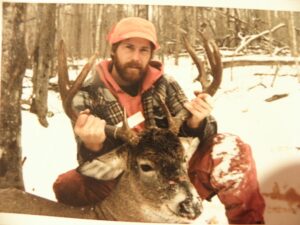The Binocular Advantage when Still Hunting
By Glen Wunderlich
Charter Member Professional Outdoor Media Association (POMA)
In this hyper-fast world we live in, slowing down doesn’t come naturally. We seem to be in a rush going to work, coming home, eating, you name it. Then, we go deer hunting and expect to be able to stalk whitetails like we were Daniel Boone. Let’s face it: Most of us aren’t experienced at stealth afield, and admittedly, my tactics were unwittingly flawed until I learned the difference between looking and seeing.
On my first deer hunting adventure to Iron County in Michigan’s Upper Peninsula in 1986, Fast Frank and I began to wonder if we had discovered a good area to hunt; we just weren’t seeing many deer. Before heading out on the third day, we planned to meet at the vehicle at noon with the idea of going somewhere else, if things hadn’t improved.
Shortly before noon, the sound of gunshots broke through the quieting snow as it piled up. I headed directly to the vehicle to hear all about it from Frank – the only other hunter in the area.
Sure enough, Frank had taken a young buck and was eager to show me where an entire group had hid. Only 20 yards from the trail was a blowdown where a group of deer bolted to parts unknown. He showed me a slender tree that took his first bullet, while he swung on a good buck, but a second shot took a lesser buck. Just like that, we were in a good spot!
An epiphany struck me like a slap in the face right then and there: I had been overlooking my surroundings for three days!
With newfound excitement, I changed my tactics and began using a binocular to discover detail that I had previously ignored. Back on the same trails that produced nothing for days, my eagerness paid off, when I found fresh tracks in the falling snow.
The deepening snow silenced the sound of my movement, as I followed the path the deer had taken. The big woods of the commercial forest gave me small windows to check and that’s exactly what I was doing when a doe appeared through the glass in the distance. To my surprise and delight, a heavy-antlered buck was close behind, as I got into a kneeling position with my Winchester model 94 in .30-30 caliber.
I flashed back to the previous season on a West Virginia hunt when I inexplicably hesitated on a shot and hit the buck a bit far back. Although fatal, I kicked myself for passing on the perfect window of opportunity. Seconds after all this developed between my ears, I released a hand-loaded, 150-grain projectile 130 yards through the heart of a giant buck with antlers like goal posts.

Upper Peninsula Buck Measured 134 6/8 Inches
And, to think we were about to leave for greener pastures empty-handed.
A good binocular is paramount to see the unseen. The still hunter must be prepared to make a quick shot at any time. Quick handling guns with low-power variable scopes or red dots or even iron sights (ugh!) go hand and hand with still hunting; however, the most important ingredient to still hunt effectively is the experience of the operator. Rushing to see what’s ahead is a good way to see the south end of a deer bounding northward.
Even if we know what constitutes a good still hunt, dry environmental conditions may prevent quiet movement through the woods making the technique frustrating; wind and soggy terrain are perfect settings for a sneak.
The goal is always to see deer before they see you. Taking no more than three steps at a time is good policy. When stopped, use the binocular – not your firearm’s scope, please! – to peer into brush piles or blowdowns. You’ll be surprised how differently things look after only a few steps.
Then slip down the trail like Davey Crockett.






